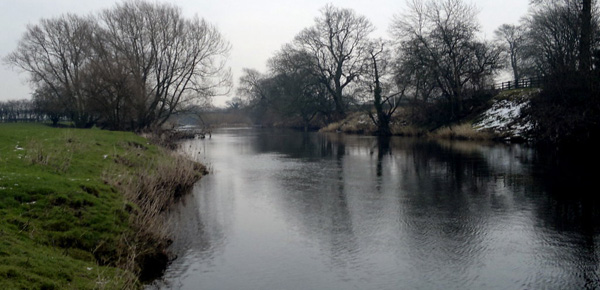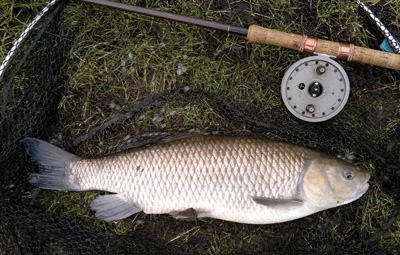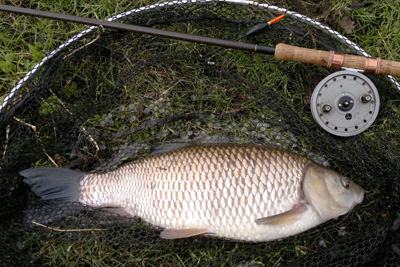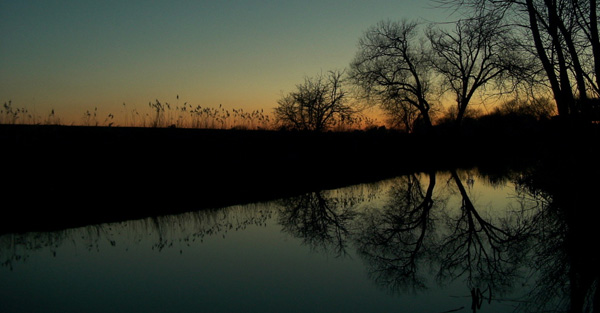This is a story about catching chub in freezing conditions, about frozen fields, icy rivers and hot aches in fingers as they thaw. But it’s not just about cold water chub fishing, it’s about how to catch chub at this time of year, how to find them and how to manage your swim to maximise your results.
The heavy rain and rapidly rising rivers of my last article have been followed by sub zero temperatures, snow and cold, clear rivers. So here I am trudging over the frozen fields along the middle reaches of the River Wharfe. The air temperature is hovering around zero and when, just out of interest, I check the water temperature it’s a balmy 2C (36F). The river is low, but looks to have risen slightly and coloured up a little from the freezing rain which fell yesterday.
My first swim is an area of deeper water just below some fast shallows. Below this there is a long, slow flowing glide which leads to another stretch of fast water. Although the glide looks featureless, at this time of year I expect to find at least one shoal of chub along its quarter mile length. The wind isn’t perfect, coming upstream and across into my face, but my intention is to float fish as this will enable me to search out the chub

The first task is to anoint the rings of my float rod with glycerine in order to slow the inevitable icing up in the freezing temperatures. Next I mix my mash and drop a couple of walnut sized balls of it about three rod lengths out. I then set up my standard chub gear, a Shimano Triple X match rod and a Rapidex centrepin loaded with low diameter 6lb line.
The cage construction Rapidex is a good general purpose trotting reel but I have my trusty Abu 501 in the bag just in case conditions take a turn for the worse. My float will be a Woody’s 5AA Avon, slightly heavier than I would use in ideal conditions, but perfect for holding its line in the slightly awkward wind I’ll have today. I find that the slightly longer Avon is less likely to tangle on the cast than the Loafer that I would use on a smaller river. My hook length is 0.13mm Powerline and the hook a size 10 Super Spade.
I run my float through the swim a few times until I get the depth right. I also take time to get the shot spacing just right, putting my bulk at just under half depth with a No 4 and two No 6 strung out below this. A Swan Shot is placed just under the float so that it’s out of the way, reducing the size of my bulk. This preparation is important as I know that my presentation is going to be just right and that if the float goes under on my first trot it’s a bite and not the bottom. The float doesn’t go under on my first trot, or indeed any of the subsequent trots; I give the swim half an hour, feeding a small ball of mash every 3 casts before moving 40 yards downstream. I now repeat the process giving each swim about twenty minutes before moving. I don’t vary the line I’m fishing on as if there are chub around they will move on to the trail of mash coming downstream.
Two hours later I’m a good way downstream, still without any indication. I’m not too worried by this as, firstly, I’ve every confidence in my method and, secondly, I know from experience that where I’m going to fish now nearly always produces some chub. About 20 yards above me the glide has shallowed up enough to give a popply surface which smoothes out just out from where I’m standing as the water deepens again. 30 yards downstream the glide shallows up again and I expect to find the chub just above this.
I feed a couple of balls of mash and run the float through a few times without any bait to get the depth right. I get a slight tangle as the hook catches around the main line just above the float so I lower the bulk shot a few inches. On goes a piece of flake and we’re fishing again. My second cast gives me another tangle so I lower the bulk shot a little more – if I have to do this again I’ll consider changing to a fixed spool reel so that I can feather the line a little as I cast.
 Three more casts and I’m in the groove, with the float running nicely down the swim and no tangles. The chub obviously approve of the presentation as the float buries and I pull into a nice fish and a few minutes later I’m unhooking a chub of around 4lb 8oz.
Three more casts and I’m in the groove, with the float running nicely down the swim and no tangles. The chub obviously approve of the presentation as the float buries and I pull into a nice fish and a few minutes later I’m unhooking a chub of around 4lb 8oz.
It would now be easy just to put on another piece of flake and carry on fishing, but if I’m going to maximise the potential of this swim I need to think about what I’m doing. When trotting I like to hook chub around 15 yards down the swim which gives me time to get the float properly under control and gives me an area above the killing zone in which I can play fish without disturbing the shoal too much. It also makes sure that I’m not looming over the chub as they feed in the relatively shallow water. This first chub was hooked about 10 yards down the swim so I start to feed my mash a little further down the swim. In these cold conditions I expect the chub to stay hugging the bottom and not follow the feed too far upstream, so they should drop back downstream a bit to take the mash.
A couple more casts and the float slides smoothly under about twenty yards downstream. It’s important not to cause too much disturbance on the strike so I pull smoothly into the fish and start to wind it back upstream. As usual the chub comes a fair way before it realises that there is something wrong so I can let battle commence well away from the shoal. Even though the water is cold these fish are giving a good account of themselves and it’s a good while before I can slip the net under another four pounder. I unhook it and pop it into the carp sack at my feet. Using a sack avoids any chance of disturbing the shoal by returning the fish and chub will lie quietly in a dark sack for an hour or so.
 The next two hours are constantly absorbing. I’m continually adjusting the position and the density (how hard I squeeze) the feed to keep the bites coming in the right area and resting the swim for a while if I get any shy bites. It’s important not to strike at quick pulls as you’ll spook the fish, either by pulling the bait out of their mouths or by causing a commotion with the quick strike. Just rest the swim for a while and have a cuppa, but remember to keep the feed going in as before.
The next two hours are constantly absorbing. I’m continually adjusting the position and the density (how hard I squeeze) the feed to keep the bites coming in the right area and resting the swim for a while if I get any shy bites. It’s important not to strike at quick pulls as you’ll spook the fish, either by pulling the bait out of their mouths or by causing a commotion with the quick strike. Just rest the swim for a while and have a cuppa, but remember to keep the feed going in as before.
As the afternoon slips gently into evening Jack Frost starts to nip at my finger ends and the rod rings need clearing every cast. I’ve now had nine chub over 4lb with the two biggest going 5lb 3oz and 5lb 1oz so I decide enough is enough. By the time I’ve packed up the full moon is silvering the frozen meadows, lighting my way back to the warmth of my car.
SOME THOUGHTS
Chub Location
Chub, like all fish, are predictable in their behaviour. As the season draws to a close they congregate in large shoals in steadier water. Places to look for them are smooth glides where the water is travelling at walking pace or slightly less. Water depth and the presence, or lack of, cover seem to matter less than the pace of the flow so don’t neglect apparently featureless stretches of water.
Chub are also creatures of habit and they will be found in the same swims season after season. Prime spots are at the bottom of the slope where a glide shallows up into a stretch of rapids. In clear conditions I don’t worry too much about the line I fish as a shoal of chub will move to intercept a trail of mash.
One thing that will cause them to move though is predation and it’s always worthwhile trying faster shallows if you don’t find the shoals in the steadier water. If pike or otters cotton on to their location they will move into the shallows to avoid them. It’s also noticeable that the chub don’t seem to be shoaling up so much on the lower Swale anymore and I put this down to otter predation breaking up the shoals.
Swim Management
Swim management used to be second nature to any river matchman worth his salt, but with the slow decline of match fishing on rivers and with many specimen anglers graduating from carp fishing it’s becoming a lost art. Put simply, it’s about developing a strategy for maximising your returns from a swim. I like to split a float fishing swim into a killing zone towards the bottom of my swim, an area in which to play fish out, and an area in which I get the float and main line aligned and behaving properly. I then adjust the rate at which I feed and where I feed to keep the bites coming where I want them. I also respond to any signs of wariness from the fish by resting the swim for a while.
It’s interesting that when having a beer with my mate Mick he said that he’d had a good catch of chub from the same swim a week earlier. He’d had ten fish and he recognised the two biggest fish from my photos – he’d weighed them at 5lb 2oz and 4lb 15oz. We’d both experienced a sudden decline in the number of bites just before we packed up and I do wonder if by effective swim management we’d both managed to catch most of the shoal. Makes you think doesn’t it?
Conclusion
We’ve only got a few weeks left of the river season and it’s prime time for chub. Float fishing is by far the best way of locating the shoals and of catching a good number of chub once you’ve located them. It’s all too easy to decide that it’s too cold and stay at home, or huddle under a brolly staring at a quiver tip, but the angler who attacks his river with a float and a well presented piece of flake is almost guaranteed success.
So, what are you waiting for?











